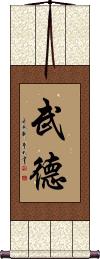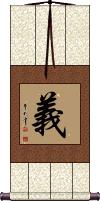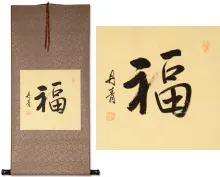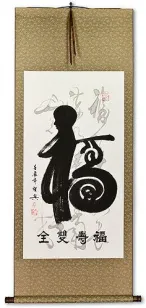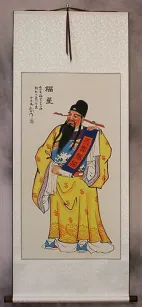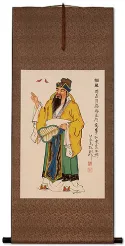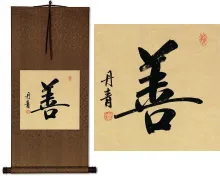Many custom options...
And formats...

Good Conduct in Chinese / Japanese...
Buy a Good Conduct calligraphy wall scroll here!
Personalize your custom “Good Conduct” project by clicking the button next to your favorite “Good Conduct” title below...
Good Conduct
善行 means good actions, good deeds, good conduct, or benevolence.
This can be the given name Yoshiyuki in Japanese.
The Foundation of Good Conduct
Quote from Confucius
This proverb, 志于道据于德依于仁游于艺, from the Analects of Confucius translates as:
Resolve yourself in the Dao/Tao/Way.
Rely on Virtue.
Reside in benevolence.
Revel in the arts.
According to Confucius, these are the tenets of good and proper conduct.
This was written over 2500 years ago. The composition is in ancient Chinese grammar and phrasing. A modern Chinese person would need a background in Chinese literature to understand this without the aid of a reference.
Martial Morality / Martial Arts Ethics / Virtue
This refers to the virtue, morality, and ethics that any practitioner of martial arts should possess.
This can be used in both Chinese and Japanese in place of English terms such as “soldierly virtue,” “good conduct” (military), “warrior ethics,” and being honorable regarding any fight or competition.
In Japanese, there is a slight variation in the last character, making it 武徳 instead of 武德 in Japan. And yes, just one little horizontal stroke is omitted. If you need the Japanese version, please choose a Japanese calligrapher, or drop me a note so that I make sure you get the characters you intend.
See Also: Morality of Mind | Morality of Deed
Justice / Rectitude / Right Decision
Also means: honor loyalty morality righteousness
義 is about doing the right thing or making the right decision, not because it's easy but because it's ethically and morally correct.
No matter the outcome or result, one does not lose face if tempering proper justice.
義 can also be defined as righteousness, justice, morality, honor, or “right conduct.” In a more expanded definition, it can mean loyalty to friends, loyalty to the public good, or patriotism. This idea of loyalty and friendship comes from the fact that you will treat those you are loyal to with morality and justice.
義 is also one of the five tenets of Confucius's doctrine.
![]() There's also an alternate version of this character sometimes seen in Bushido or Korean Taekwondo tenets. It's just the addition of a radical on the left side of the character. If you want this version, click on the image to the right instead of the button above.
There's also an alternate version of this character sometimes seen in Bushido or Korean Taekwondo tenets. It's just the addition of a radical on the left side of the character. If you want this version, click on the image to the right instead of the button above.
This is also a virtue of the Samurai Warrior
See our page with just Code of the Samurai / Bushido here
See Also: Judgment | Impartial | Confucius Tenets
This in-stock artwork might be what you are looking for, and ships right away...
Gallery Price: $31.00
Your Price: $16.88
Gallery Price: $65.00
Your Price: $39.88
Gallery Price: $90.00
Your Price: $49.88
Good Fortune / Prosperity Saint Wall Scroll
Discounted Blemished
Gallery Price: $71.00
Your Price: $39.00
Good Luck Special Calligraphy Wall Scroll
Discounted Blemished
Gallery Price: $53.00
Your Price: $29.00
Handmade Good Luck Special Calligraphy Wall Scroll
Discounted Blemished
Gallery Price: $35.00
Your Price: $19.00
Unique Good Luck Special Calligraphy Wall Scroll
Discounted Blemished
Gallery Price: $31.00
Your Price: $17.00
Decorative Good Luck Special Calligraphy Wall Scroll
Discounted Blemished
Gallery Price: $31.00
Your Price: $17.00
Gallery Price: $65.00
Your Price: $39.88
Not the results for Good Conduct that you were looking for?
Below are some entries from our dictionary that may match your Good Conduct search...
| Characters If shown, 2nd row is Simp. Chinese |
Pronunciation Romanization |
Simple Dictionary Definition |
業 业 see styles |
yè ye4 yeh hajime はじめ |
More info & calligraphy: Karmadeed; act; work; performance; (personal name) Hajime karman, karma, "action, work, deed"; "moral duty"; "product, result, effect." M.W. The doctrine of the act; deeds and their effects on the character, especially in their relation to succeeding forms of transmigration. The 三業 are thought, word, and deed, each as good, bad, or indifferent. Karma from former lives is 宿業, from present conduct 現業. Karma is moral action that causes future retribution, and either good or evil transmigration. It is also that moral kernel in which each being survives death for further rebirth or metempsychosis. There are categories of 2, 3, 4, 6, and 10; the 六業 are rebirth in the hells, or as animals, hungry ghosts, men, devas, or asuras: v. 六趣. |
五行 see styles |
wǔ xíng wu3 xing2 wu hsing gogyou / gogyo ごぎょう |
More info & calligraphy: Five Elements(1) (See 五大・ごだい・1) the five elements (in Chinese philosophy: wood, fire, earth, metal and water); the five phases; wu xing; (2) {Buddh} five practices of the Bodhisattvas; (3) (See 六信五行) the five pillars of Islam; (surname, given name) Gogyou The five lines of conduct. I. According to the 起信論 Awakening of Faith they are almsgiving; keeping the commandments; patience under insult; zeal or progress; meditation. II. According to the 涅槃經 Nirvana Sutra they are saintly or bodhisattva deeds; arhat, or noble deeds; deva deeds; children's deeds (i. e. normal good deeds of men, devas, and Hinayanists); sickness conditions, e. g. illness, delusion, etc.; — into all these lines of conduct and conditions a Bodhisattva enters. III. The five elements, or tanmātra— wood, fire, earth, metal, and water; or earth, water, ire, air, and ether (or space) as taught by the later Mahāyāna philosophy; idem 五大. |
善行 see styles |
shàn xíng shan4 xing2 shan hsing yoshiyuki よしゆき |
More info & calligraphy: Good Conduct(noun - becomes adjective with の) (ant: 悪行) good deed; good conduct; benevolence; (given name) Yoshiyuki practice of good deeds |
修習力 修习力 see styles |
xiū xí lì xiu1 xi2 li4 hsiu hsi li shujūriki |
The power acquired by the practice of all (good) conduct; the power of habit. |
挙げる see styles |
ageru あげる |
(transitive verb) (1) to give (an example); to list; to enumerate; to show; to display; to cite; (transitive verb) (2) to summon up (e.g. all of one's energy); to gather; (transitive verb) (3) to arrest (a criminal); to capture; to seize; to apprehend; (transitive verb) (4) to nominate (e.g. for a position); to recommend; to propose (something); (transitive verb) (5) to hold (an event, ceremony, etc.); to conduct (a wedding); (transitive verb) (6) to raise (an army); to take up arms (against something); to rise up; (transitive verb) (7) to make known; to inform; to spread word; to win fame; (transitive verb) (8) (dated) to have (a child); to bear (a child); to raise (children); (transitive verb) (9) (See 手を挙げる・1) to raise; to elevate; (transitive verb) (10) (See 声を上げる・1) to make (a loud sound); to raise (one's voice); (transitive verb) (11) to earn (something desirable); to achieve (e.g. a good result); to obtain |
等流果 see styles |
děng liú guǒ deng3 liu2 guo3 teng liu kuo tōru ka |
Like effects arise like causes, e.g. good from good, evil from evil; present condition in life from conduct in previous existence; hearing from sound, etc. |
行供養 行供养 see styles |
xíng gōng yǎng xing2 gong1 yang3 hsing kung yang gyō kuyō |
The making of offerings, to go to make offerings. |
品行方正 see styles |
hinkouhousei / hinkohose ひんこうほうせい |
(adj-na,adj-no,n) (yoji) irreproachable conduct; good conduct; high morals |
普賢菩薩行願讚 普贤菩萨行愿讚 see styles |
pǔ xián pú sà xíng yuàn zàn pu3 xian2 pu2 sa4 xing2 yuan4 zan4 p`u hsien p`u sa hsing yüan tsan pu hsien pu sa hsing yüan tsan Fugen bosatsu gyōgan san |
King of Aspirations to Good Conduct |
The following table may be helpful for those studying Chinese or Japanese...
| Title | Characters | Romaji (Romanized Japanese) | Various forms of Romanized Chinese | |
| Good Conduct | 善行 | zenkou / zenko | shàn xíng shan4 xing2 shan xing shanxing | shan hsing shanhsing |
| The Foundation of Good Conduct | 誌于道據于德依于仁遊于藝 志于道据于德依于仁游于艺 | zhì yú dào jù yú dé yī yú rén yóu yú yì zhi4 yu2 dao4 ju4 yu2 de2 yi1 yu2 ren2 you2 yu2 yi4 zhi yu dao ju yu de yi yu ren you yu yi | chih yü tao chü yü te i yü jen yu yü i | |
| Martial Morality Martial Arts Ethics Virtue | 武德 | bu toku / butoku | wǔ dé / wu3 de2 / wu de / wude | wu te / wute |
| Justice Rectitude Right Decision | 義 义 | gi | yì / yi4 / yi | i |
| In some entries above you will see that characters have different versions above and below a line. In these cases, the characters above the line are Traditional Chinese, while the ones below are Simplified Chinese. | ||||
Successful Chinese Character and Japanese Kanji calligraphy searches within the last few hours...


